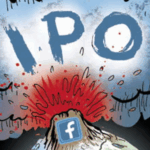 Facebook’s growth led to a strong first quarter and stock that shot upward post-earnings.
Facebook’s growth led to a strong first quarter and stock that shot upward post-earnings.
Facebook’s Q1 2016 revenue grew 57% year over year to $5.4 billion, compared to $3.5 billion the same time last year. Advertising comprised $5.2 billion of that revenue.
Of that ad revenue, 82% came from mobile, compared to 73% in Q1 2015.
Meanwhile, monthly active users (MAUs) grew 15% year over year to 1.65 billion. Mobile MAUs were 1.51 billion, up 21% year over year.
Revenue is growing much faster than user growth, and that comes down to increasing time spent. According to the GroupM Interaction report released earlier this week, Facebook grabbed 38 minutes per unique user, compared to 23 minutes per unique user from Google-owned sites.
Facebook’s ad impressions went up 50% year over year, and cost per ad increased 5%, a sign that it had more supply to work with.
Facebook was tight-lipped about other initiatives, however, like Instant Articles, Facebook Audience Network (FAN), video, its chatbots and how it’s dealing with declines in Facebook updates.
When asked about the monetization impact of Facebook Instant Articles, for example, CEO Mark Zuckerberg simply said he was excited that publications can use it to “deliver a good experience.”
Regarding FAN, Facebook COO Sheryl Sandberg described it as a “strategic investment in ad tech.” She noted how eBay used FAN across Facebook and Instagram for a Latin American real estate app, reaching more users and driving down cost per installs by 57%.
While recent reports like the IAB Digital Advertising Revenue report show digital advertising on the uptick as TV declines slightly, Sandberg said Facebook’s increased advertising revenue didn’t come from one particular area.
Sandberg highlighted a way Facebook complemented a TV buy: T-Mobile used the social network to tease and test a Super Bowl ad featuring Drake. User response inspired the carrier to swap out its original 30-second ad for a 60-second spot.
While Facebook did not detail its video revenue growth, it noted that Instagram users uploaded 40% more videos over the past six months. On Facebook, three times more people are creating and sharing videos compared to a year ago.
Facebook also touched on bots. During the developer conference F8, the company unveiled a bot API that allows brands and publications to communicate with users. Sandberg said monetization of Facebook Messenger will be slow and deliberate, adding that the company will draw on its experience in designing ads and measuring their effectiveness.
Facebook’s developments around Instant Articles, chatbots and Messenger demonstrates how the company is addressing changing user behavior.
According to a widely cited article on The Information earlier this month, “original” sharing on Facebook, or people posting about their lives, declined 21%. Facebook is trying to figure out how to keep people coming back to Facebook as user-generated content declines.
“The way we are sharing is changing,” Zuckerberg said in response to a question about that decline.
He pointed out how people use Instagram or Messenger to share individually or with small groups. Messenger and the VR platform Oculus also fall into Facebook’s broader mandate, Zuckerberg said, to “build good products” that tap into people’s “deep desire to express themselves and connect.”













